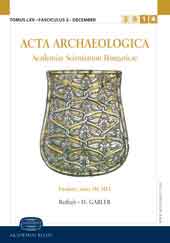Untersuchungen zur Keramikproduktion von Brigetio
Studies on the ceramic production of Brigetio
Author(s): G. FényesSubject(s): Archaeology, Military history, Social history, Ancient World
Published by: Akadémiai Kiadó
Keywords: Brigetio; Komárom; Szôny; Romans; legion camps; archaeology;
Summary/Abstract: Brigetio (today's Komárom / Szôny) lies on the right bank of the Danube, opposite the river mouth of the Waag. In Roman times Brigetio acted as one of the four legion camps (Vindobona today's Vienna, Carnuntum Bad-German Altenburg Petronell and Aquincum Óbuda) on the Limes road from Aquincum to Arrabona. Since in the area of Brigetio the native population left no significant traces of settlement, the beginnings of the local settlement system date back to the time of the Roman occupation. This settlement system consisted of three parts: legion camp, canabae and civil settlement. First, the vexillations of Legio XIII Gemina, XIIII Gemina and XV Apollinaris built a military camp. The Legion XI Claudia was stationed as the first legion, which was replaced by the Legio XXX Ulpia Victrix in 106. From 118/119 the Legio I Adiutrix was stationed here. Until the end of Roman rule in Pannonia she remained the permanent crew of Brigetio. North of the camp were the military pottery workshops, the so-called Gerhát and the workshop on Kuruczdomb. The pottery workshops west of the city took care of supplying the population of the civilian town with utility ceramics, but these were completely destroyed by track construction work at the end of the 19th century. Your area is unsuitable for archaeological research.
Journal: Acta Archaeologica Academiae Scientiarum Hungaricae
- Issue Year: 54/2003
- Issue No: 1-2
- Page Range: 101-163
- Page Count: 63
- Language: German
- Content File-PDF

